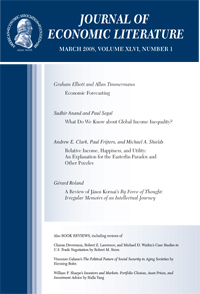儿童实验如何为经济学提供信息
IF 11.5
1区 经济学
Q1 ECONOMICS
引用次数: 3
摘要
在过去的几十年里,实验方法为经济学提供了深刻的见解。其中一个有贡献的领域是对儿童的实验研究,在这个领域,人们探索了各种各样的进步,从塑造市场和制度的人类行为的进化,到早期生活如何影响塑造后来的生活结果。我们首先开发了一个经济偏好测量框架,为如何解释儿童实验数据提供了一个视角。接下来,我们调查了在我们的框架内提供一般经验见解的工作,并提供了对儿童使用的实验方法的综合总结。最后,我们提供了在儿童身上成功进行实验的10个技巧,包括考虑儿童能力、因果识别以及与招募和实施相关的后勤问题等因素。我们设想,随着社会科学家开始更加充分地认识到儿童是市场的积极参与者,他们(可能)对经济激励做出可预测的反应,儿童实验研究将在未来几十年成为一个高增长的研究领域。(jj90, d11, d83, d91, j13, j16, z13)本文章由计算机程序翻译,如有差异,请以英文原文为准。
How Experiments with Children Inform Economics
In the past several decades, the experimental method has lent deep insights into economics. One area that has contributed is the experimental study of children, where advances as varied as the evolution of human behaviors that shape markets and institutions to how early life influences shape later life outcomes, have been explored. We first develop a framework for economic preference measurement that provides a lens into how to interpret data from experiments with children. Next, we survey work that provides general empirical insights within our framework and provide a comprehensive summary of experimental methods used with children. Finally, we provide 10 tips for pulling off experiments with children, including factors such as taking into account child competencies, causal identification, and logistical issues related to recruitment and implementation. We envision the experimental study of children as a high-growth research area in the coming decades as social scientists begin to more fully appreciate that children are active participants in markets who (might) respond predictably to economic incentives. (JEL C90, D11, D83, D91, J13, J16, Z13)
求助全文
通过发布文献求助,成功后即可免费获取论文全文。
去求助
来源期刊

Journal of Economic Literature
ECONOMICS-
CiteScore
17.80
自引率
0.80%
发文量
49
期刊介绍:
Commencing in 1969, the Journal of Economic Literature (JEL) serves as a vital resource for economists, offering a means to stay informed about the extensive literature in the field. Each JEL issue features commissioned, peer-reviewed survey and review articles, book reviews, an annotated bibliography categorizing new books by subject, and an annual index of dissertations from North American universities.
 求助内容:
求助内容: 应助结果提醒方式:
应助结果提醒方式:


